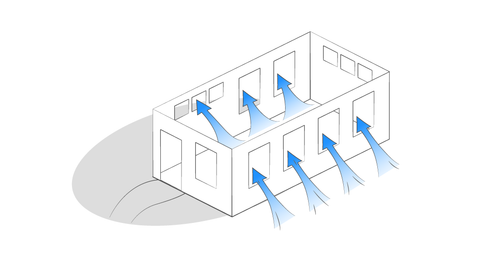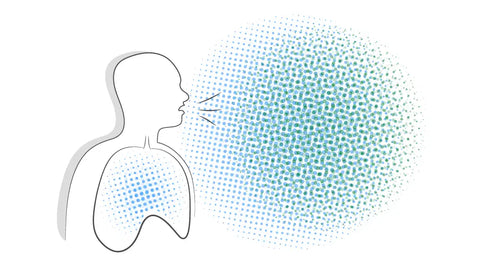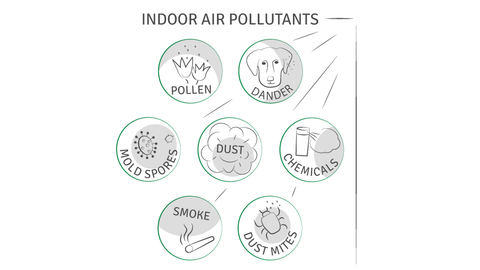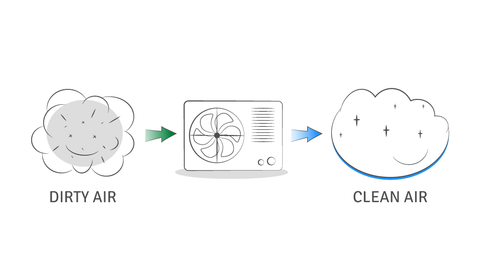No Products in the Cart

Besides the home, the school is the other indoor environment where children spend most of their time in. Knowing this, shouldn’t it be a priority for schools to have good indoor air quality?
Long ago, classroom ventilation was marked as an important determinant of indoor air quality, but the ventilation rates currently do not meet building standards. They are far from the ideal environment for developing children. Nationally, 90% of schools are under-ventilated and some research shows that bad airflow harms students’ health and performance.
The start of the 2020-2021 school year, unlike previous school years, had a much different climate and routine. Many schools used assorted teaching methods which include virtual classrooms, in-person instruction, and a combination of both. Now it is imperative that, for a safe learning environment, schools must have been assessed the current building ventilation and overall indoor air quality.

Generally indoor air quality plays an important role in schools. Proper ventilation in schools has been shown to work side by side with calculation, concentration, and memory.
There’s suggestive evidence for an association between ventilation rates with the attention and performance of students, some two prerequisites of an efficient learning process. Good ventilation rates have been proven to improve performance and increases the children’s chances of success; while low ventilation rates are associated with lowered test scores, increased absenteeism, and more respiratory symptoms in schoolchildren.
Even books and researches explain how low-quality air can wreak havoc on children. Particularly how proper ventilation and indoor air quality lowers the number of airborne pollutants such as smoke, allergens, viruses (such as SARS-CoV2 that carries the Covid-19 disease), mold spores, pollen, and other microorganisms that can cause allergies, asthma, cardiovascular disease, and in the worst-case scenario, premature death! Scary?
Although some of these health effects may seem to only cause short-term effects, the EPA informs that “health effects from indoor air pollutants may be experienced soon after, or possibly, years later.”
It’s plain, simple, common knowledge that breathing in polluted air will make you sick. Invariably, this means that if low-quality air affects your health negatively, then clean air will make you healthier, right?

Asides from the very good case that high-quality air is a good step towards reducing the risk of infections, breathing in clean air provides a whole host of benefits to young school children.
Test schools (schools observed by researchers) found that the children in rooms with cleaner air were more energetic. Those who had been normally limited by asthma and allergies had a higher rate of participation in sports activities.
So to say, breathing cleaner air in class leads to more energy and participation during gym and recess.

Poor air quality leads to coughing and sneezing. When children breathe clean air, they do not get sick so often.
According to the CDC, one of the leading causes of school absenteeism in schools accounting for over 14 million missed school days per year is asthma-related illnesses. At its worst, poor air quality in schools takes children out of the classroom due to these respiratory infections.
Now, a step towards improving indoor air quality in schools is to improve overall ventilation.
Eliminating sources of pollution, nevertheless, can greatly increase air quality indoors. Common pollution sources in schools include paints, toxic cleaners, and materials with formaldehyde. Periodically opening the classroom windows can help balance the flow of outdoor air inside to improve air quality. However, circulating air is not the same as cleaning it. Increasing air circulation is a good place to start, sure, but, well, circulation is not the same as purifying the air.
The best way to understand proper ventilation in classrooms is to think about it in terms of the dilution of contaminants in the indoor space. Either you want to dilute the air by bringing in more outdoor air, or clean that air to remove the particles.
Two removal mechanisms: dilution or cleaning.

We have the remedies already stated above as simple as opening the windows, or using box fans, or holding class outdoors if possible. However, the answer we may be searching for is Air Purification. In other words, cleaning the air we share.
And the most recommended for indoors is the usage of portable air purifiers. This helps to provide enough clean air.
On top of the remedial efforts, using an air purifier like the Cetrix air purifiers to eliminate 99.97% of airborne pollutants, if not for other reasons, has an immediate effect. It maintains the optimal air quality levels in the classroom all so easily.
All in all, schools need to know to properly ventilate and also clean the air inside the classrooms.
Selecting Air Purifiers for Schools
As there are compelling shreds of evidence that air quality affects student learning, actions should then be taken to reduce the impact of these on students.
With schools reopening and children returning to schools, everyone is working as hard as possible to find solutions to make the air (especially) in the classrooms as safe as possible. Many schools may not be able to reach the required levels of ventilation, but that should not hinder them from doing what they can to make their air safer — like adding portable air purifiers.
Air purifiers for schools should not be excluded as part of a safe reopening. If schools do not already have air purifiers for the classrooms selected, now is just about the time to consider getting them.

For air purifiers, they use no harsh chemicals to help cleanse the air and reduce airborne particulate. They can even provide beneficial air quality improvements after the pandemic. Good enough older buildings and structures can profit from using compact air purifiers due to the simple and economical installation.
Cetrix offers a variety of air-purifying solutions to improve indoor air quality in schools and protect children from disease transmission (through airborne contaminants). These systems utilize high-quality filters to capture airborne contaminants like mold spores, dust, respiratory droplets, viruses, pollen, and other microorganisms.
School air purifiers are not that common, but it is common sense to put one in the classroom if the importance of air quality is understood. Air purification really should be included for an effective school hygiene strategy. And air purifiers provide maximum protection around the year—not just when it’s too cold to open the classroom windows.
The air that we breathe is likened to the gasoline we put in our cars. For high-performance needs, it would need premium gas to be more efficient, long-lasting, and perform better.
As the best deployable and immediate solution in classrooms, schools are now considering portable air purifiers. This provides students a much safer air quality environment, especially using such as Cetrix which has been school tested already.
There are also more reasons schools would select Cetrix.
Cetrix purifiers create a safer environment for school children by reducingair contamination that makes them sick and unable to perform at their best. They have different products intended for classrooms of different sizes, corridors, libraries, and school buses. The products can eradicate bacteria, viruses, gases, smoke, and allergens.
As studies show that good indoor air quality in the classroom increases student's ability to finish tasks that require everything from concentration and calculation to memory, cleaning the air becomes top priority.
One of the most straightforward recommendations has been the introduction of air purifiers into each classroom. This is needed because to effectively purify a room, you must move a lot of air around as particles simultaneously float and settle. And a purifier must be able to clean and circulate a room's full volume of air.
Extra airflow from open windows and HVAC vents can help disperse particle concentrations (so long as infected air isn’t blown directly from person to person).
Basically, schools are searching for not only just a solution to providing the highest level of clean air but one that offers the least amount of classroom disruption while at it.
Solutions range in efficiency, aesthetics, size, sound, and more. Ultimately, efficiency is very critical to improving indoor air quality. True efficiency is one of the most criteria, but also, you should consider the following:
Know this - All purifiers are not all the same. Either the filter has to meet or exceed ratings by the American Society of Heating, Refrigerating and Air-Conditioning Engineers (ASHRAE) or there is another quality marker to contend with. Amongst all, Cetrix purifiers provide an end-to-end solution to air purification and disinfection. And for the best results, high performance air purifiers like Cetrix’s ensure that a school classroom is healthy, with clean air.